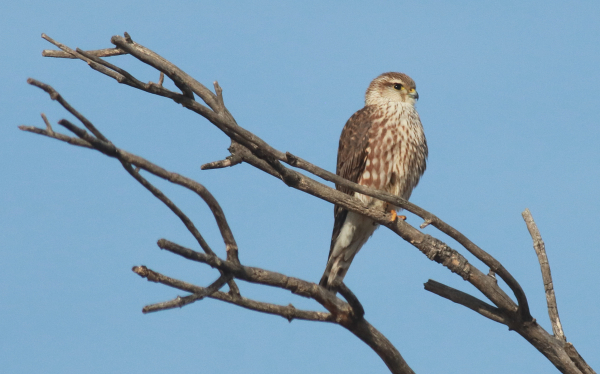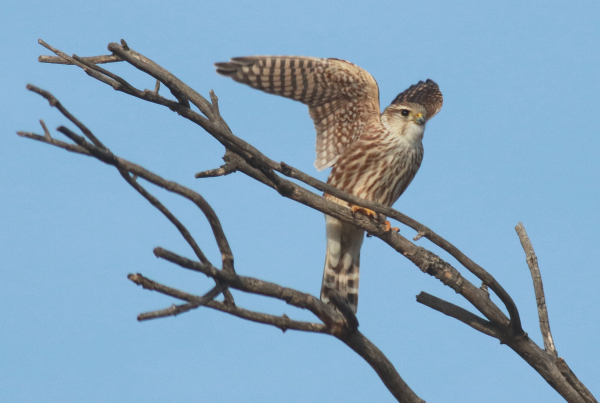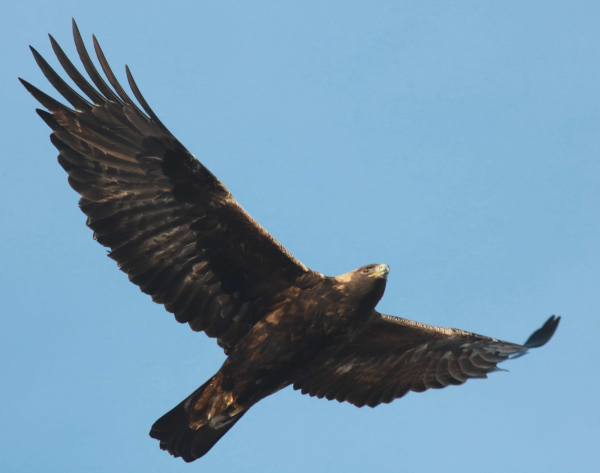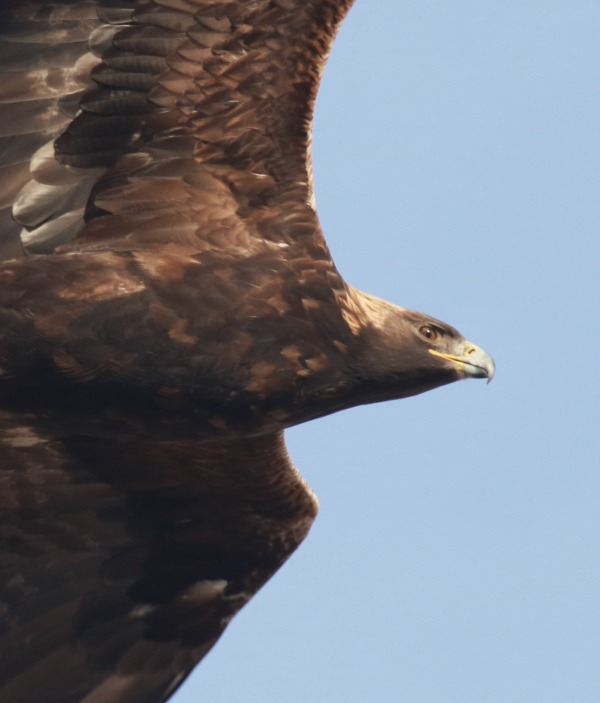You know it all – you’ve read the bird photography basics provided weekly in previous articles, all I have to share with you – now it’s time to get in the field where you can use these techniques and technical settings with birds before you. Find the birds, approach the birds, spend some extra time with individual birds, react to the bird’s actions, and be sure you are using your camera and lens combo in all the best ways. Visit a birding hotspot on a sunny day, a wooded hiking trail, a favorite lakeside or marsh edge, a beach filled with a variety of birds, or try a day trip drive – like I did last Thursday.
I had been waiting for weeks for a sunny day with a minimum wind in the Pierre area so I could re-visit my premier raptor wintering hotspot, which I refer to as “SoDak,” an abbreviation of sorts for its location in central South Dakota. A surprise change in the weather forecast for Thursday, which I received late Wednesday, signaled an excellent day for birding, and in retrospect, it provided some exciting, surprising, and fulfilling photo opportunities. Therefore, I thought it was an excellent opportunity to share some valuable information with you about how I was able to get into position, then take advantage of trusting birds to acquire some fine images.

To begin with, permit me to share that I wish to photograph all the birds I see on these SoDak road trips, but Thursday only a percentage of the raptors I found provided an opportunity to photograph them; no non-raptors provided a photo op. Birds of prey are special birds and if you can get within range of raptors, they are larger birds with broad wingspans that can provide dramatic photographs when everything works out. On this particular road trip, I observed a total of 65 different diurnal raptors including 9 impressive species, along with 1 nocturnal raptor – although it was obviously active during the day too.
The day was raptor-filled, including 13 Golden Eagles, 10 Bald Eagles, 15 Rough-legged Hawks, 17 Red-tailed Hawks, 1 big first-year Ferruginous Hawk, 4 Northern Harriers (2 males and 2 immatures), and 5 falcons – a male Prairie Falcon, 3 Merlins, and the last raptor of the day, a male American Kestrel hunting from a big bent-over sunflower head – 65 raptors in all – plus a mostly nocturnal hunter, a beautiful young Snowy Owl.
Of this total, a small percentage of the raptors sighted provided photo opportunities, and an even smaller number that led to some featured photographs. For example, the young Ferruginous Hawk was close, but it was backlighted in a less than pleasing way; it provided a nice documentary photo though. Then there was the male American Kestrel perched atop a big bent-over sunflower head, but again the sun was positioned to the southwest and I was southeast of the kestrel with no chance of repositioning within the sunflower field. Others simply flew in directions that weren’t in my photo path or were perched far out of range. Here though, I will concentrate on the best photo sessions I enjoyed last week in SoDak.

Merlin Magic
All 3 Merlins materialized when I was checking out other raptors. While trying for a photo of an uncooperative Red-tailed Hawk, a little Merlin quickly distracted me and redirected my attention as it zipped through the treetops that lined a frozen stream. It landed at the top of a tangle of bare branches, leaving me on the wrong side of the sun. However, there was a meandering track along the edge of the trees that would allow me to reposition with the sun at my back and the Merlin before me. But would the Merlin permit my cautious approach?
I held my breath as I eased my vehicle past the Merlin, as I tried to find the best possible opening between tree branches that provided the best view of the Merlin with the sun at my back. It wasn’t a perfect break in the branches, but as I settled for the best view I could get given the falcon’s position, I turned off the engine, twisted back toward the Merlin with my camera in hand, and took a quick photo to begin with. Leaning my telephoto lens against the open window frame, I took a couple more photos as the little falcon turned its head this way and that, probably looking for avian prey while simultaneously watching for avian predators.
It was prime time for photography on this sunny afternoon – 3 pm – and I had my camera set at my go-to 400 ISO with an aperture of f8, which yielded 1/2000 per second shutter speed using the aperture priority (Av) mode setting. After the first few photos, I relaxed a bit and watched the Merlin closer, marveling at how cute it was, and although it wasn’t possible to tell if it was a female or an immature bird, it seemed to be a youngster judging by its fresh plumage. When photographing the perched raptor, as always I tried to accent its tiny hooked beak by taking photos when its head was turned with blue sky behind the beak. Too often, the beak can easily be lost among feathers or background elements, and I find it’s best to try to accent a raptor’s beak whenever possible.
Although I relaxed a bit to enjoy this rare extended period in the company of a Merlin, I was prepared and alert for the bird’s next move. Indeed, it’s a good thing I was alert because I was able to take a photo the instant the Merlin made a momentary false start at what must have been a hunting flight. It abruptly raised its wings, thereby raising its body upright and lowering its tail in balance – for just a second – then it was off, hurtling into spirited flight through the branches to the other side of the stream where I lost sight of it.
I did follow the Merlin’s flight initially through my telephoto lens, but I’m sorry to say the resulting flight photos were not sharp. I did take them at most opportune positions, but whether a 1/2000 shutter speed wasn’t adequate, or whether my telephoto motion was a factor (probably), the flight photos didn’t work out. But hey, I still had the initial photo of the Merlin raising its wings high an instant before take-off, which I really like, in addition to some photos of the mini-falcon in repose.
As you know, I’m always aware of how my actions might affect a bird or flock of birds, and I weigh that factor every time I consider trying an approach for a photo. In this case, I was glad it permitted my approach, and allowed me to spend some extra time in its company. I was especially happy that my approach to the Merlin didn’t appear to alter the falcon’s behavior. If it changed its behavior, I don’t think it would have done anything to harm the bird in any way; it was on the move, on the hunt, moving from place to place, and it simply allowed me to share a little time with it within telephoto range.

Surprise Snowy
After viewing a couple dozen raptors, I stopped to take a look with binoculars at a couple birds at a crossroads. Before me was a Rough-legged Hawk, and up the other road a Red-tail Hawk was flying, but I was momentarily stumped when I took an extra-long view at a large bird perched at the top of an adjacent hill. From the considerable distance, the hawk-sized bird had a light body color with an obvious white face, but it took a moment to realize it was an owl – a Snowy Owl. I promptly headed up the road, which passed directly beneath the wooden utility pole at the top of the hill where the owl had a commanding view of a broad expanse of surrounding landscape in all directions.
I was excited, but cautious not to press too close to the owl, stopping a bit prematurely perhaps, but as long as the owl was not alarmed, my judgement worked. I took a couple documentary photos, then studied the impressive owl through my binoculars, which always seem to provide a better, brighter view than my camera lens. The owl was a beautifully marked first-year Snowy with new plumage. Again, I enjoyed the opportunity to spend some time with this striking bird as it was obviously hunting in the bright late-afternoon light (although perhaps not with the same earnest as it might make after dark when rodents are probably more active).
The tranquil scene was broken as I heard the approach of a loud ranch truck rumbling toward us sans muffler. As the truck passed, the owl took flight, but I caught a break in that after crossing the road it turned to fly parallel to my position, highlighted by perfect sunlight! I followed the owl’s flight through my telephoto, hoping for the best and knowing the conditions were hard to beat. I was thrilled to have the unexpected opportunity for flight photos, and bid the tundra owl good luck as I resumed my raptor transect.
The above photo episode is an example of the kind of regular traffic-oriented flushes that take place when raptors and other birds perch near a road, but it is a testament to the merits of my cautious approach and positioning. And even when a bird flushes, it often just repositions to a similar perch, which the young Snowy did a couple hundred yards down the road.
For the flight photos, I had the same f8 aperture setting, but against the sky, the shutter speed was 1/3200 of a second – fast enough to stop the action of the Snowy wingbeats in some of the resulting images. Keep in mind though, that a good action photo doesn’t need to be absolutely sharp. If you get an image with the eyes sharp, but the wings showing some blurred motion, that can be a good photo too, as long as it’s pleasing to you. In some cases, the bird can be a total blur, showing a range of motion, but still portray a pleasing, maybe artistic, but definitely action-dominated image.

The Golden Hour
An hour later, after viewing and documenting a few more raptors photographically, I approached a small roadside cottonwood grove frequented by Golden Eagles and hawks. I thought I saw a raptor among the branches, and moments later, a pair of Goldens took flight, prompting me to hop out of my vehicle in anticipation for them to fly into the best light. Even better, both birds began circling the trees, low and close to my position. The bigger female had a huge crop of food that bulged from her lower throat, and she only made one pass before seeking a perch within sight farther south, but the male circled an inordinate number of times, low and often directly overhead.

The Golden Eagle circled repeatedly low overhead, providing images that show details of its eye, beak, and many individual feathers.
|
In this same area I’ve had a number of memorable interactions with Golden Eagles that circled low above me as I photographed them. I had to wonder if this was a certain bird, or a couple of repeat circlers. Nonetheless, I thanked the pair with a “hoka hey” salute, and headed for my last destination on the SoDak transect.
After reviewing the resulting photos, this bird provided some uncharacteristic images to share with you that show some quality details, including its eyes, beak, and certain feathers. It’s interesting to note that with the fading light, I switched my aperture to f7, and the camera provided a 1/800 of a second shutter speed for the close-up image, which was actually ample to stop the action of the circling eagle yet provide enough depth of field to keep all the eagle within the field of focus.
A mile to the west I could already see a big Golden Eagle perched where I had left a very trusting eagle at the end of my last visit to the area in December. As I drove closer, I also noticed a second Golden perched about a half-mile south of the first. As before, I needed to pass close to the bigger eagle to get to a vantage point where I was between the sun and the eagle for the best lighting. And again, the eagle permitted me to ease cautiously by it and swing my vehicle to the side for optimum positioning.
In this case, I was less concerned about such a close approach to such a wary species, because I recognized that this individual was the same most trusting Golden I’ve encountered twice before this winter. I settled in for a relaxed photo session, and eventually drove uneventfully away, satisfied that my “eagle buddy” didn’t mind my imposition. By that time the light was fading, I was at the end of my raptor transect, and it was time to head back north to Pierre and another 200 miles beyond that to spend the evening reviewing the photos of the day, and tallying my raptor count totals. It was a wonderful day to be a birder – a wonderful day to photograph raptors!
Article and photographs by Paul Konrad
Share your bird photos and birding experiences at editorstbw2@gmail.com